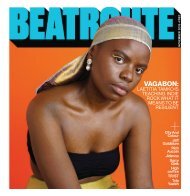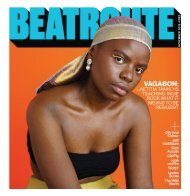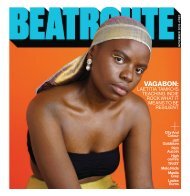BeatRoute Magazine B.C. print e-edition - October 2016
BeatRoute Magazine is a monthly arts and entertainment paper with a predominant focus on music – local, independent or otherwise. The paper started in June 2004 and continues to provide a healthy dose of perversity while exercising rock ‘n’ roll ethics.
BeatRoute Magazine is a monthly arts and entertainment paper with a predominant focus on music – local, independent or otherwise. The paper started in June 2004 and continues to provide a healthy dose of perversity while exercising rock ‘n’ roll ethics.
You also want an ePaper? Increase the reach of your titles
YUMPU automatically turns print PDFs into web optimized ePapers that Google loves.
WHAT A CITY IS FOR<br />
bringing the city back to the people amongst the hip allure of ownership<br />
Sadie Barker<br />
When asked about the origins of<br />
his new book, What a City Is For,<br />
East Vancouver-based author and<br />
teacher Matt Hern refers back nearly<br />
ten years ago to trips to Portland<br />
with his graduate students. The days<br />
consisted of meetings with nonprofit<br />
organizations and planners<br />
— faces of Portland’s innovative<br />
urbanization — all of whom, it was<br />
quickly noted, were white. In an effort<br />
to diversify, Hern sought connections<br />
with initiatives in Portland’s black<br />
and Latino communities. This proved<br />
challenging because, he says, “Portland<br />
is the whitest city ever.” But it wasn’t<br />
always, and tracing the development of<br />
Portland to its current reputation — a<br />
liberal-dwelling locale, ripe with craft<br />
beer and green space — narrates an<br />
upsetting history.<br />
Portland’s development in<br />
the last 20 years is shadowed by<br />
racist constitution, discriminatory<br />
real-estate practice, and systemic<br />
displacement. Today Albina, once a<br />
predominately black neighborhood,<br />
is unrecognizable: white and uppermiddle<br />
class, with exclusive housing<br />
prices. The story surrounding it —<br />
a shift from black community, to<br />
“classic ghetto,” to site of renewed<br />
investment — is ubiquitous. It dictates<br />
the social pathologies, like addiction,<br />
unemployment, and displacement that<br />
arise when a community is subject to<br />
racial gentrification. This includes the<br />
withdrawing of social services and housing<br />
condemnation, typically followed by<br />
renewed investment in the neighborhood<br />
by those who can afford it.<br />
Hern, who has<br />
spearheaded many initiatives<br />
in his Commercial Drive<br />
community including<br />
Groundswell: Grassroots<br />
Economic Alternatives, is familiar<br />
with the problematic relationship<br />
between improvement and capital.<br />
This phenomenon is reflected in the<br />
skyrocketing real estate of his own<br />
neighborhood and the “For Sale” sign<br />
on his front door. Hern though, is<br />
hasty to differentiate between degrees<br />
of displacement, deeming his own<br />
inconsequential in comparison to<br />
Albina or the theft of Indigenous land.<br />
Portland’s urban narrative is a<br />
common one and it’s pervasive in<br />
many cities, Vancouver included.<br />
Commodification of land is an oftenpresumed<br />
concept within Western<br />
property rights, but it’s also, Hern<br />
claims, the root of civic peril. Indeed, in a<br />
city like Vancouver, with a 50/50 split of<br />
renters and buyers, property ownership<br />
fosters oppositional politics — owners<br />
seeking high property value, renters<br />
seeking low-rent. But should land be<br />
commodified? Property ownership is<br />
entrenched in Western consciousness,<br />
but that that doesn’t make it right.<br />
A reworking may be in order.<br />
Hern suggests investing in cooperative,<br />
non-market provisions of property,<br />
recognizing the importance of common<br />
and unfettered land, and looking<br />
towards Indigenous concepts of<br />
sovereignty. Because what is a city for?<br />
A city is for everyone.<br />
Matt Hern discusses and launches his<br />
book, What a City Is For, at the Djavad<br />
Mowafaghian World Art Center on<br />
<strong>October</strong> 21.<br />
Matt Hern looks at the epidemic that is gentrification<br />
and the scars it leaves on a community<br />
VANCOUVER IN THE SEVENTIES<br />
the dawn of Vancouver’s social justice backbone caught on film<br />
Jennie Orton<br />
As the matrix has made pocketsized<br />
camera computers available to<br />
almost every person on the planet to<br />
document the world around them,<br />
the art of photo documentation has<br />
gone from quality to quantity in the<br />
blink of a photo burst. As a result, you<br />
can notice two intriguing truths while<br />
strolling the 400 images on display at<br />
The Museum of Vancouver’s Vancouver<br />
in the Seventies: Photos from a Decade<br />
that Changed the City exhibit: the<br />
vocation of photojournalism has, by<br />
accessibility, become an evolved artistry<br />
less dependent on instinct and timing,<br />
and much of what gives Vancouver its<br />
human pulse remains unchanged.<br />
Curator Viviane Gosselin talks<br />
about the exhibition, which is a sister<br />
project of the book by the same name<br />
written by retired Vancouver Sun<br />
research librarian Kate Bird, and the<br />
decision to categorize the images by<br />
theme instead of chronologically, as they<br />
are presented in the book; ideas such as<br />
“Building in Vancouver,” “Performing in<br />
Vancouver,” and “Playing in Vancouver,”<br />
to name a few. This practice allowed<br />
for attention to be paid to the<br />
vibe of the city and how much the<br />
decade was seminal in establishing<br />
Vancouver’s personality.<br />
“Something I find captivating is<br />
protesting in Vancouver in the ‘70s, a lot<br />
of the issues are resonating with today,”<br />
notes Gosselin. The exhibit features<br />
photos documenting the Gastown<br />
Riots in 1971 (a clash between smokein<br />
protesters wanting the legalization<br />
of marijuana and police), the Battle of<br />
Jericho (a showdown between hippies<br />
squatting in the abandoned barracks of<br />
Jericho Beach and police that resulted<br />
in a dialogue about affordable options<br />
for young travellers in the city), and the<br />
1971 founding of Greenpeace Canada in<br />
Vancouver amidst concerns of nuclear<br />
testing and pipelines.<br />
“For every decade since the ‘20s<br />
there have always been a lot of people<br />
in the streets protesting and exercising<br />
their democratic right so I think it has<br />
become something of a Vancouverite<br />
ethos: that we want to manifest and we<br />
want to express ourselves and we do<br />
that as a collective, and the streets<br />
are the outlet or the place to do that,”<br />
Gosselin continues.<br />
What sets these images apart is the<br />
compositional expertise adopted by those<br />
who chose to make photojournalism their<br />
career in the 1970s.<br />
“Certainly when you look at<br />
those 400 images, they are amazing<br />
historical documents but they are<br />
also aesthetically stunning,” Gosselin<br />
posits. “They are beautiful art<br />
documents.”<br />
Vancouver in the Seventies: Photos from<br />
a Decade that Changed the City runs at<br />
the Museum of Vancouver from <strong>October</strong><br />
13 - February 26.<br />
28 CITY<br />
<strong>October</strong> <strong>2016</strong>


















